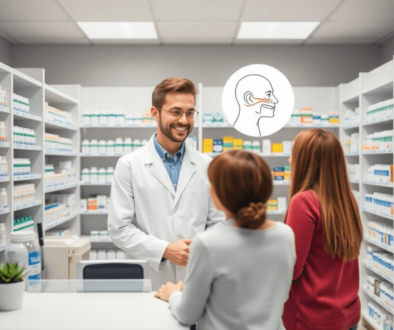Managing Side Effects of ADHD Medications: Tips from Pharmacists
Managing the side effects of ADHD medications is crucial for ensuring individuals can tolerate and stick to their prescribed treatments. By addressing these side effects promptly, we can improve medication compliance and overall outcomes.
Pharmacists, including those at MisterPharmacist, play a vital role in supporting individuals with ADHD. They are valuable members of the healthcare team who provide guidance on medication usage, side effect management, and monitoring. With their expertise, pharmacists enhance patient understanding and optimize treatment effectiveness.
The significance of online pharmacies like MisterPharmacist, which offer fast prescription delivery in Toronto, is also growing in this context.
Understanding Pharmacological Treatments for ADHD
Pharmacological treatments for ADHD play a crucial role in managing symptoms and improving daily functioning. There are two main categories of medications that are commonly prescribed:
1. Stimulant Medications
Stimulant medications like methylphenidate and amphetamines are the first-line treatment for ADHD due to their effectiveness in enhancing focus and reducing impulsivity.
- They work by increasing the levels of norepinephrine and dopamine in the brain, which are neurotransmitters involved in attention and behavior regulation.
- By balancing these neurotransmitters, stimulants help individuals with ADHD concentrate better, control their impulses, and stay organized.
- Available in short-acting (3-4 hours) and long-acting (8-12 hours) formulations for tailored symptom control throughout the day.
2. Non-Stimulant Options
Non-stimulant medications such as atomoxetine, guanfacine, and clonidine are recommended for patients who do not respond well to or experience intolerable side effects from stimulants.
These medications work differently from stimulants but can also improve symptoms of ADHD by targeting other neurotransmitters in the brain.
Understanding the mechanisms of action and differences between stimulant and non-stimulant medications is crucial for healthcare providers to make informed decisions about individualized treatment plans for patients with ADHD.
In some cases, patients with ADHD may also experience bladder infections or other minor ailments that require additional pharmacological interventions. It’s important for healthcare providers to consider all aspects of a patient’s health when devising a treatment plan.
Additionally, parents of pediatric patients may need guidance on redosing medications after vomiting, which can be a common issue when managing ADHD with medication.
Managing Common Side Effects of Stimulant Medications
Common side effects associated with stimulant medications for ADHD, such as those detailed in this comprehensive comparison of ADHD medications in Canada, include:
1. Appetite Loss
Many individuals experience a decrease in appetite when taking stimulant medications. This can impact weight and growth, especially in children. Strategies to manage this side effect include:
- Taking medication with or after meals to reduce the impact on appetite.
- Choosing nutrient-dense foods for meals and snacks to ensure adequate nutrition.
2. Insomnia
Stimulants can interfere with sleep, leading to difficulties falling or staying asleep. To address insomnia, individuals can try:
- Taking stimulant medications early in the day to minimize their impact on nighttime sleep.
- Incorporating relaxation techniques before bedtime to promote better sleep quality.
3. Mood Changes
Some individuals may experience mood swings or irritability while on stimulant medications. To manage mood changes, consider:
- Consulting healthcare providers if significant mood disturbances occur.
- Adjusting the timing or dosage of medications in collaboration with healthcare professionals.
4. Tics
Stimulant medications can sometimes exacerbate tics in individuals with underlying tic disorders. Strategies to address tics include:
- Monitoring tic symptoms closely and discussing any changes with healthcare providers.
- Exploring alternative treatment options if tics worsen significantly.
By understanding these common side effects and implementing effective management strategies, individuals can optimize the benefits of ADHD medications while minimizing potential drawbacks. For further information on managing these side effects, you might find valuable insights in this resource from Beacon Health System.
The Role of Pharmacists in Monitoring Physical Health Parameters During ADHD Treatment
Monitoring physical health parameters such as blood pressure and heart rate is a critical component when managing side effects of ADHD medications. Stimulant medications, while effective for symptom control, can influence cardiovascular function due to their stimulating effects on the nervous system.
Active Role of Pharmacists
Pharmacists play an active role in:
- Regularly measuring blood pressure and heart rate to detect any abnormal changes early.
- Identifying patients who may be at increased risk for cardiovascular complications based on their medical history or baseline vital signs.
- Educating patients and caregivers about symptoms like palpitations, chest pain, dizziness, or shortness of breath that warrant immediate medical attention.
Importance of Monitoring
The importance of this monitoring arises from potential cardiovascular risks associated with stimulant use. Although serious events are rare, stimulants can cause elevated heart rate and increased blood pressure, which may exacerbate pre-existing heart conditions or lead to new issues if left unchecked.
Collaboration with Prescribers
Pharmacists collaborate closely with prescribers to adjust medication regimens when abnormal cardiovascular findings occur. This collaboration helps balance treatment efficacy with safety considerations. By maintaining vigilance over these physical health parameters, pharmacists contribute significantly to minimizing adverse effects and promoting safe medication use during ADHD treatment.
Awareness of Other Health Conditions
It’s essential for pharmacists to also be aware of other health conditions that might complicate ADHD treatment. For instance, syphilis is making a comeback and understanding its symptoms can aid in early detection and prevention. Furthermore, if a patient is on multiple medications, pharmacists should be vigilant about the risk of overmedication, which can lead to serious health complications.
Dietary Factors in Medication Absorption
Additionally, certain dietary factors can influence medication absorption and overall health. For example, knowing how to take zinc for maximum absorption could provide patients with helpful insights into improving their nutritional intake while undergoing treatment.
Exploring Non-pharmacological Supports for Individuals with ADHD
Non-pharmacological interventions play a vital role in the comprehensive treatment of ADHD. These approaches focus on addressing behavioral and psychological aspects of the condition to improve daily functioning and overall well-being.
Role of Psychoeducation and Behavioral Management Training in Treatment
- Psychoeducation involves educating individuals with ADHD, their families, and caregivers about the disorder. It aims to enhance understanding of symptoms, treatment options, and strategies for coping with challenges. By increasing knowledge and awareness, psychoeducation empowers individuals to better manage their condition effectively.
- Behavioral management training provides practical skills and strategies to help individuals with ADHD improve their behavior, attention span, and organizational abilities. This type of intervention often includes techniques such as behavior modification, time management skills, and organizational strategies tailored to the individual’s specific needs.
The Importance of Cognitive-Behavioral Therapy (CBT)
Cognitive-behavioral therapy (CBT) is another valuable non-pharmacological approach that focuses on changing negative thinking patterns and behaviors associated with ADHD. CBT helps individuals develop coping mechanisms, improve problem-solving skills, and enhance self-regulation abilities. Through CBT, individuals can learn to challenge distorted thoughts, set realistic goals, and improve impulse control.
Complementing Medication Therapy
These non-pharmacological supports complement medication therapy by addressing different aspects of ADHD management, such as improving executive functioning skills, enhancing self-esteem, reducing impulsivity, and strengthening social relationships. By incorporating psychoeducation, behavioral management training, and cognitive-behavioral therapy into treatment plans, individuals with ADHD can benefit from a holistic approach that addresses both the biological and psychological components of the disorder.
The Collaborative Role of Pharmacists in Managing Side Effects and Preventing Medication Misuse During ADHD Treatment
Pharmacists serve as a critical link between patients and prescribers, focusing on medication adherence counseling to ensure effective and safe use of ADHD medications. You benefit from their expertise when they educate you about proper dosing schedules, potential side effects, and the importance of consistent medication intake. This guidance helps minimize missed doses and prevents abrupt discontinuation that could worsen symptoms or cause withdrawal effects.
Adjusting treatment plans collaboratively is another key responsibility pharmacists fulfill. They monitor your response to therapy and communicate any concerns—like persistent side effects or suboptimal symptom control—to the prescribing clinician. This teamwork allows for tailored adjustments, such as modifying dosage or switching between stimulant and non-stimulant options, enhancing both safety and efficacy.
Pharmacists also play a crucial role in managing side effects. For instance, if you’re experiencing heartburn as a side effect of your medication, this guide offers natural remedies and lifestyle changes to alleviate such discomforts.
Preventing medication misuse remains a top priority in ADHD care. Pharmacists provide practical advice on safe storage to reduce risks of diversion or accidental ingestion by others. They also watch for signs of misuse or abuse, especially with stimulant medications that have potential for dependency. By fostering open communication about these issues, pharmacists help maintain responsible medication use while supporting your therapeutic goals.
Engaging with pharmacists regularly creates a supportive environment that promotes adherence, optimizes treatment outcomes, and safeguards against misuse throughout your ADHD management journey.
Conclusion
Consistent follow-up care is crucial in managing side effects of ADHD medications. It is essential for achieving optimal treatment outcomes. A multi-modal approach that combines medication management, additional support methods, and regular monitoring ensures that side effects are minimized while therapeutic benefits are maximized.
Key reasons to prioritize regular follow-up include:
- Early identification and management of emerging side effects
- Adjustment of medication dosages or formulations based on individual response
- Reinforcement of medication adherence and safe use practices
- Continuous support through education and behavioral strategies
Pharmacists play a vital role as accessible healthcare professionals in this process. They monitor progress, provide education, and collaborate closely with prescribers to maintain a balance between effectiveness and safety throughout the ADHD treatment journey.
You can enhance your care by engaging regularly with your pharmacist and healthcare team to address concerns promptly and adapt your treatment plan as needed.



